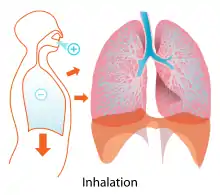Inhalation
Inhalation (or Inspiration) happens when air or other gases enter the lungs.

Inhalation of air
Inhalation of air, as part of the cycle of breathing, is a vital process for all human life. The process is autonomic (though there are exceptions in some disease states) and does not need conscious control or effort. However, breathing can be consciously controlled or interrupted (within limits).
Breathing allows oxygen (which humans and a lot of other species need for survival) to enter the lungs, from where it can be absorbed into the bloodstream.
Other substances – accidental
Examples of accidental inhalation includes inhalation of water (e.g. in drowning), smoke, food, vomitus and less common foreign substances[1] (e.g. tooth fragments, coins, batteries, small toy parts, needles).
Other substances – deliberate
Recreational use
Legal – helium, nitrous oxide ("laughing gas")
Illegal – various gaseous, vaporised or aerosolized recreational drugs
Diagnostic
Various specialized investigations use the inhalation of known substances for diagnostic purposes. Examples include pulmonary function testing (e.g. nitrogen washout test, diffusion capacity testing (carbon monoxide, helium, methane)) and diagnostic radiology (e.g. radioactive xenon isotopes).
Therapeutic
Gases and other drugs used in anaesthesia include oxygen, nitrous oxide, helium, xenon, volatile anaesthetic agents. Medication for asthma, croup, cystic fibrosis and some other conditions.
Mechanism
Inhalation begins with the contraction of the muscles attached to the rib cage; this causes an expansion in the chest cavity. Then takes place the onset of contraction of the thoracic diaphragm, which results in expansion of the intrapleural space and an increase in negative pressure according to Boyle's law. This negative pressure generates airflow because of the pressure difference between the atmosphere and alveolus.
The inflow of air into the lungs occurs via the respiratory airways. In health, these airways begin with the nose.[2][3] It is possible to begin with the mouth, which is the backup breathing system. However, chronic mouth breathing leads to, or is a sign of, illness.[4][5][6] They end in the microscopic dead-end sacs(alveoli) always opened, though the diameters of the various sections can be changed by the sympathetic and parasympathetic nervous systems. The alveolar air pressure is therefore always close to atmospheric air pressure (about 100 kPa at sea level) at rest, with the pressure gradients that cause air to move in and out of the lungs during breathing rarely exceeding 2–3 kPa.[7][8]
Other muscles that can be involved in inhalation include:[9]
Hyperinflation
Hyperinflation or hyperaeration is where the lung volume is abnormally increased, with increased filling of the alveoli. This results in an increased radiolucency on X-ray, a reduction in lung markings and depression of the diaphragm. It may occur in partial obstruction of a large airway, as in e.g. congenital lobar emphysema, bronchial atresia and mucus plugs in asthma.[10]
Yoga
Yogis such as B. K. S. Iyengar advocate both inhaling and exhaling through the nose in the practice of yoga, rather than inhaling through the nose and exhaling through the mouth.[11][12][13] They tell their students that the "nose is for breathing, the mouth is for eating."[12][14][15][11]
See also
- Exhalation
- Inhalant – psychoactive drugs consumed through inhalation
- List of terms of lung size and activity
- Mouth breathing
- Obligate nasal breathing
- Respiratory system
- Smoking - a specific inhalation route
- Breathing
- Work of breathing
Further reading
- Nestor, James (2020). Breath: The New Science of a Lost Art. Riverhead Books. ISBN 978-0735213616.
References
- Passàli, D; Lauriello, M; Bellussi, L; Passali, GC; Passali, FM; Gregori, D (2010). "Foreign body inhalation in children: an update". Acta Otorhinolaryngol Ital. 30 (1): 27–32. PMC 2881610. PMID 20559470.
- Turowski, Jason (2016-04-29). "Should You Breathe Through Your Mouth or Your Nose?". Cleveland Clinic. Retrieved 2020-06-28.
- "Your Nose, the Guardian of Your Lungs". Boston Medical Center. Retrieved 2020-06-29.
- Dahl, Melissa (2011-01-11). "'Mouth-breathing' gross, harmful to your health". NBC News. Retrieved 2020-06-28.
- Valcheva, Zornitsa (January 2018). "THE ROLE OF MOUTH BREATHING ON DENTITION DEVELOPMENT AND FORMATION" (PDF). Journal of IMAB. Retrieved 2020-05-31.
- Gross, Terry (2020-05-27). "How The 'Lost Art' Of Breathing Can Impact Sleep And Resilience". National Public Radio (NPR)/Fresh Air. Retrieved 2020-06-23.
- Koen, Chrisvan L.; Koeslag, Johan H. (1995). "On the stability of subatmospheric intrapleural and intracranial pressures". News in Physiological Sciences. 10 (4): 176–178. doi:10.1152/physiologyonline.1995.10.4.176.
- West, J.B. (1985). Respiratory physiology: the essentials. Baltimore: Williams & Wilkins. pp. 21–30, 84–84, 98–101.
- Nosek, Thomas M. "Section 4/4ch2/s4ch2_10". Essentials of Human Physiology. Archived from the original on 2016-03-24.
- "Hyperinflation". Medcyclopaedia. GE. Archived from the original on 2011-12-08.
- Yoga Journal Editors (2017-04-12). "Q&A: Is Mouth Breathing OK in Yoga?". Yoga Journal. Retrieved 2020-06-26.
{{cite web}}:|last=has generic name (help) - Payne, Larry. "Yogic Breathing: Tips for Breathing through Your Nose (Most of the Time)". Yoga For Dummies, 3rd Edition. Retrieved 2020-06-26.
- Himalayan Institute Core Faculty, Himalayan Institute Core Faculty (2017-07-13). "Yogic Breathing: A Study Guide". Himalayan Institute of Yoga Science and Philosophy. Retrieved 2020-06-26.
- Krucoff, Carol (2013). Yoga Sparks. New Harbinger Publications. ISBN 9781608827022. Retrieved 2020-05-31.
- Jurek, Scott (2012). Eat and Run. Houghton Mifflin. ISBN 978-0547569659. Retrieved 2020-05-31.
-solution.jpg.webp)

